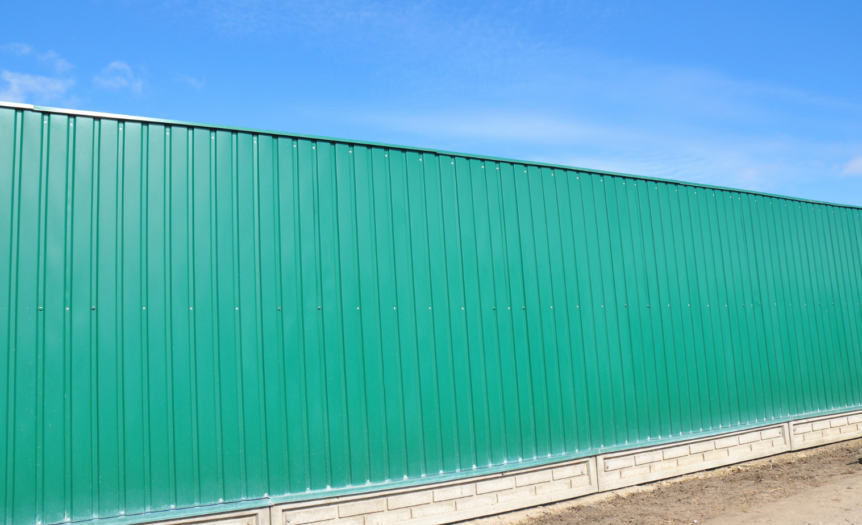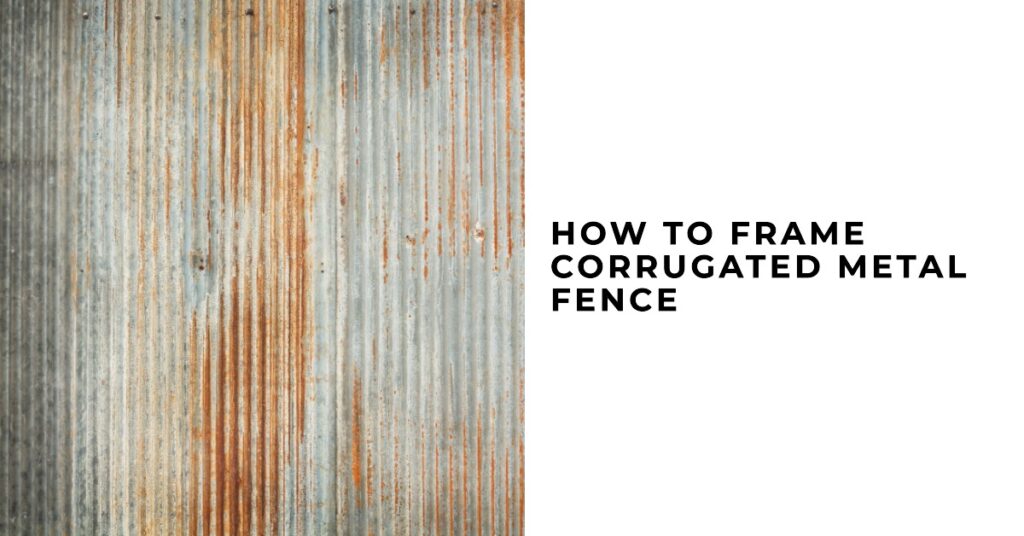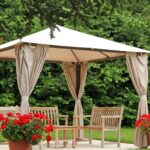Fencing plays a crucial role in enhancing the privacy, security, and visual appeal of your property. If you’re looking for a durable, low-maintenance, and eco-friendly option that offers a unique aesthetic touch, then framing a corrugated metal fence might just be the perfect solution for you.
In this blog post, we’ll guide you through everything from understanding the benefits of choosing corrugated metal to taking you step-by-step on how to frame it correctly.
The Benefits Of Using Corrugated Metal For Fencing
Corrugated metal fencing offers a myriad of benefits, including durability and longevity due to its high resistance to weathering and corrosion, low maintenance requirements, aesthetically pleasing appearance for modern and industrial designs, and eco-friendliness thanks to its recyclable materials.
Durability And Longevity
One of the most notable advantages of using corrugated metal for fencing is its remarkable durability and longevity. This material is known for its resilience against harsh weather conditions, including heavy rain, strong winds, and even hailstorms.
Moreover, corrugated metal does not succumb easily to rust or corrosion when properly coated or galvanized. For example, galvanized metal attached to wood will significantly improve the fence’s lifespan due to the added protection from moisture damage found in other materials like traditional wooden fences.
Low Maintenance
One of the biggest advantages of using corrugated metal for fencing is that it requires very little maintenance. Unlike wood, which can rot or warp over time and needs to be treated regularly, corrugated metal panels are resistant to weather damage and insect infestations.
In addition, because the panels are so durable, they don’t need to be replaced as often as other types of fencing materials.
Overall, low maintenance is one of the key reasons why many homeowners are choosing corrugated metal for their fences.
Aesthetically Pleasing
Corrugated metal fencing is not only sturdy and long-lasting but also very aesthetically pleasing, adding a touch of industrial chic to any property. The clean lines and simple design of corrugated metal panels make them an excellent choice for modern or minimalist properties.
Alternatively, homeowners can opt for rusted or painted finishes on the metal panels to create a rustic or colorful look that complements various types of landscaping. For example, painting the fence black creates a sleek contrast between greenery while choosing earthy brown hues will blend beautifully with natural elements like wood decks and stone paths.
Eco-Friendly Material
Corrugated metal fencing is an excellent choice for homeowners who want to reduce their carbon footprint. This type of fencing is environmentally friendly because it’s made from recycled materials and can be recycled again whenever you’re ready to replace it.
Choosing a material that is sustainable and eco-friendly not only benefits the environment but also saves money over time. The long-lasting durability of a corrugated metal fence reduces the need for frequent replacements, further minimizing waste and environmental impact.
Materials And Tools Needed For Framing A Corrugated Metal Fence
To frame a corrugated metal fence, you will need basic materials and tools such as wooden posts, concrete mix, screws and drill, level, post hole digger, and of course the corrugated metal panels.
Corrugated Metal Panels
Corrugated metal panels are an excellent choice for fencing due to their durability, low-maintenance needs, and eco-friendliness. These panels come in different shapes and sizes that can be customized according to the specific requirements of your fence.
When selecting a type of corrugated metal for your fence, it’s important to consider factors like longevity, cost-effectiveness, and aesthetic appeal.
During installation, care should be taken when handling these panels due to their sharp edges. Sliding them carefully into channels on the frames ensures they are securely fitted without risking any injuries during the process.
Additionally, applying a rust-inhibiting coating helps keep these panels in top shape for years while reducing maintenance costs over time.
Wooden Posts
Wooden posts are an essential component of framing a corrugated metal fence. When choosing wooden posts, it is important to select pressure-treated wood for added durability and resistance against rotting.
To install wooden posts, holes must first be dug using a post hole digger. Once the holes are dug, mix concrete and pour it into each hole to secure the post in place.
Properly securing wooden posts and properly spacing them out along your fencing line will ensure that your metal fence remains strong against any weather conditions or outside forces from animals or other elements.
Level
Using a level is an essential step in framing a corrugated metal fence. It ensures that the posts are straight and even, preventing any potential leaning or wobbling of the fence.
A level tool comes in different sizes, but a standard 4-foot level will suffice for this project. The bubble inside should be centered between the two lines to ensure accuracy.
Checking each post individually with the level before proceeding with installation will save time and effort down the line by avoiding costly adjustments later on.
Post Hole Digger
A post hole digger is an essential tool needed for framing a corrugated metal fence. It makes the process of digging holes for the fence posts much quicker and easier than using a shovel alone.
A typical post hole digger consists of two handles connected by two long, pointed scoops that are used to pull soil out of the ground in circular motions. When using a post hole digger, it is important to consider factors such as depth and spacing between posts.
Correctly placed posts help ensure the stability and longevity of your fence. Remember to also check with local utility companies before digging to avoid hitting pipes or wires underground.
Concrete Mix
To ensure that your corrugated metal fence stays sturdy and secure, you will need to mix concrete. The materials needed for mixing concrete include Portland cement, sand, gravel or crushed stone, and water.
Once you have dug post holes for the wooden posts that will hold up the fence, place your post in the hole and fill it with mixed concrete until it is level with the ground.
Use a level tool to make sure each post is straight before letting the concrete set.
Screws And Drill
Screws and a drill are essential tools needed for framing a corrugated metal fence. When selecting screws, make sure they are strong enough to securely attach the metal panels to the wooden posts.
Using self-tapping screws is recommended since they can easily drill through both materials without pre-drilling holes in the metal or wood. To avoid splitting of the wood, it’s important to use high-quality screws that won’t break easily during installation.
Additionally, using proper fastening techniques is crucial for achieving a long-lasting and sturdy fence structure. Screws should be spaced appropriately along each panel edge at equal intervals while ensuring that they don’t exceed 24 inches apart from one another.
Overall, investing in reliable screws and a powerful drill will save time and money on repairs later on down the road while also improving your fence’s durability over time.This way you could enjoy your beautiful outdoor space without any worries about maintenance or repairs for years to come!
Steps To Frame A Corrugated Metal Fence
To frame a corrugated metal fence, you first need to plan and measure the fence line, dig post holes, set the posts using concrete mix, install rails and cross-braces to support the panels, attach the corrugated metal panels to the frame with screws and drills, and finish off with any necessary trimming or touches.
Planning And Measuring The Fence Line
Before starting the installation process, it is important to plan and measure the fence line carefully. Begin by marking the corners of the fence using stakes driven into the ground.
Measure twice before cutting any materials to make sure that you have accurately calculated how much corrugated metal you will need for your fencing project. Be sure to account for any slopes or changes in terrain, as this can affect both post placement and panel lengths.
Digging Post Holes And Setting The Posts
The first step in framing a corrugated metal fence is digging post holes and setting the posts. Using a post hole digger, create evenly spaced holes along the fence line, typically about 6 to 8 feet apart depending on your design.
Once the holes are dug, fill them with concrete mix and insert the wooden posts. It’s important to ensure that each post is level before allowing the concrete to dry completely.
Choosing pressure-treated wood for posts can help prevent rotting over time and extend the longevity of your fence. Remember to mark buried utility lines or call your local utility company before digging any holes to avoid accidents or damage to underground pipes and wires.
Installing Rails And Cross-Braces
After digging the post holes and setting the posts, it’s time to install rails and cross-braces. These components provide additional support for your corrugated metal fence.
To attach rails and cross-braces, you’ll need screws and drill. First, measure the distance between each pair of adjacent fence posts to ensure that the rails will fit properly.
Next up is attaching cross-braces which should be installed at a 45-degree angle between opposite corners of two posts. This technique helps to prevent warping or sagging over time due to changes in weather conditions.
By following these steps for installing rails and cross-braces correctly, your corrugated metal fence will be sturdy and long-lasting!
Attaching Corrugated Metal Panels
Once all the wooden posts and rails are securely in place, it’s time to attach the corrugated metal panels. The first step is to slide them carefully into the channels on your metal-framed fence, taking care not to snag yourself on any sharp edges.
Once they’re in place, you’ll want to use self-tapping screws driven through the panels and into the metal framing beneath.
It’s worth noting that galvanized steel is often used for fencing material since it adds an extra layer of durability when attached to wood. Additionally, vertical installation will help prevent dust from settling atop your fence line while also ensuring a sturdy barrier against wind or other outdoor elements.
Finishing Touches
After the corrugated metal panels have been attached to the fence frame, there are a few finishing touches that can be added for extra protection and aesthetic appeal. Applying a rust-inhibiting coating to the metal panels will prevent rust and corrosion, keeping your fence looking great for years to come.
To ensure maximum durability, it is recommended that you choose vertical installation over horizontal installation. Vertical installation allows water and debris to slide off easily rather than accumulating on top of horizontal panels which could lead to damage over time.
Tips For Building A Sturdy And Long-Lasting Corrugated Metal Fence
To ensure a sturdy and long-lasting corrugated metal fence, use pressure-treated wood for posts, choose appropriate post spacing based on the fence’s height, apply a rust-inhibiting coating to metal panels, opt for vertical installation for better durability, and finish with painting or sealing the fence for added protection.
Choosing Appropriate Post Spacing For Height
When building a corrugated metal fence, it’s essential to choose the appropriate post spacing for height. This means determining how far apart each post should be based on the overall height of your fence.
As a general rule of thumb, for shorter fences (around 6 feet), you’ll want to space your posts around 6-8 feet apart. For taller fences (up to 8 feet or more), you’ll need to reduce that spacing to around 4-6 feet.
By using appropriate post spacing based on your fence height, along with quality materials like pressure-treated wood and galvanized metal panels, you can ensure a sturdy and long-lasting corrugated metal fence suitable for any home or property needs.
Using Pressure-Treated Wood For Posts
One key tip for building a sturdy and long-lasting corrugated metal fence is to use pressure-treated wood for the posts. Pressure-treated wood has been treated with chemicals to resist rot, insects, and decay, making it ideal for outdoor use.
Fence posts made from untreated wood can quickly deteriorate and compromise the strength of the entire fence structure.
Using pressure-treated wood ensures that your fence posts remain strong and stable over time, even in harsh weather conditions. It also helps prevent insect infestations that could potentially weaken or damage the fence.
Applying A Rust-Inhibiting Coating To Metal Panels
To ensure that your corrugated metal fence lasts for years to come, it’s important to protect it from rust. One way to do this is by applying a rust-inhibiting coating to the metal panels.
There are several different types of rust inhibitors available on the market, ranging from paint-on coatings to spray-on sealers. Some popular options include Rust-Oleum and Por 15.
Applying a rust inhibitor typically involves cleaning the surface of the panels first, then using a brush or sprayer to evenly coat them with the product. It’s important not to rush this step as proper coverage helps ensure maximum protection against rust.
Opting For Vertical Installation For Better Durability
In addition to choosing the right materials and fastening techniques, opting for vertical installation can also improve the durability of your corrugated metal fence. By framing the panels vertically rather than horizontally, you can prevent water from pooling on top of the panels which could lead to rusting or other damage over time.
To frame your fence vertically, simply attach 2×4 wooden pieces along the length of each panel using screws and drill. These pieces should be attached parallel to each other with enough space between them to allow for drainage and ventilation.
By taking these simple steps in combination with selecting appropriate materials like galvanized metals while installing a corrugated metal fence posthole digger alongside measuring tapes are technically valuable tools that will contribute significantly in improving overall fencing performance giving good look and lasting as long as possible!
Painting Or Sealing The Fence For Added Protection
It is highly recommended to paint or seal your corrugated metal fence for added protection against rust and weathering. A fresh coat of paint can prevent the metal from corroding, while a protective sealant can help maintain the color and texture of the fencing material.
Before applying any finish, it’s essential to clean the fence panels thoroughly with soap and water. Once dry, you can use a brush or roller to apply high-quality exterior paint specifically designed for metal surfaces.
Alternatively, you could choose a clear sealant that provides UV protection without altering the appearance of your fence.
Conclusion
Framing a corrugated metal fence may seem like a daunting task, but with the right tools and materials, it can be done easily. With the benefits of durability, low maintenance, and aesthetic appeal, it’s no surprise that homeowners are turning to this style of fencing more frequently.
By following our simple steps and tips for building a sturdy and long-lasting fence, you’ll have your new farmhouse-style fence up in no time! Just remember to plan carefully before beginning installation to ensure safety around utility lines and proper measurements for purchasing materials.









